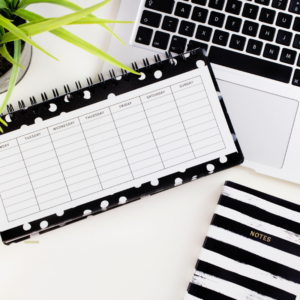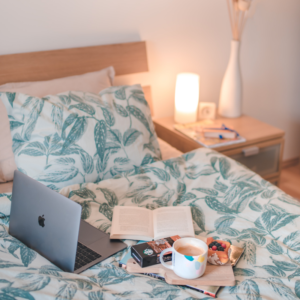6 ways to model a healthy work/life balance
Whether it’s a new term or you simply want to introduce healthier patterns/habits, modelling a healthier work-home balance for kids and teens can help them learn the best ways to reduce stress and handle pressure from deadlines. By showing a more healthy, sustainable balance between our work and home lives, we can also show our kids how to work through any emotional upset from their day, while practising what we preach about relaxation and self-care.

According to research revealed by Barnardo’s, nearly half of children aged 12 feel sad or anxious weekly, while 70% of 16 year olds report feeling this way each week. The main causes? 65% feel overwhelmed by school, 42% worry about their future, and 31% worry about problems at home. A staggering 80% of 16 year olds feel stressed. Could we be unintentionally adding to these feelings of being overwhelmed?
Statistics from the Mental Health Foundation show more than 40% of workers neglect other aspects of their life because of work. This can increase our vulnerability to mental health problems, with common side-effects of this poor work/life balance including stress, irritability and a general unhappiness in how your life currently is. But how many of us are aware of a problem not just for our own well-being, but for our kids as well?
By modelling a healthier work/life balance, we can help demonstrate practical ways in which we manage our responsibilities and stresses, helping them to find and emulate ways that they can apply as their own responsibilities and potential for stress increases. We share six simple ways you can show (not tell) kids and teens how they can achieve a better work/life balance.

Ask: why now?
Working from home can become habit, rather than a necessity. If you need to work out of your regular office hours, try showing a healthy balance by setting yourself a time limit for how long you will work from home. Ask yourself: do I really need to do this now? What is the benefit of working on this now, not tomorrow? If it may make you feel less stressed and more calm ahead of the new day, great; but if it’s just extending the time in which you worry about work deadlines and meetings, this could be worth addressing.
 If you do need to complete work outside of your regular hours, try to keep these contained, and try not to let it become a daily habit.
If you do need to complete work outside of your regular hours, try to keep these contained, and try not to let it become a daily habit.
By setting yourself specific time in which you can get extra work done, it can help show kids and teens that completing homework can be beneficial and by not putting things off, it can boost our mood and overall feelings of calmness.
By limiting how long you spend working outside of work hours, you also help reinforce boundaries that it’s OK to switch off, and that work doesn’t need to filter into every spare moment we have.
Put down the work emails
Avoid answering work emails during every spare moment before or during the school run, over dinner, or throughout the night while trying to relax with your family; this can show children a constant pressure to always need to be ‘on’ and ‘available’ for outside influences.
While encouraging a healthy work ethic is commendable, setting the unrealistic expectation that they should be working every spare moment could make them feel more pressured or guilty for taking downtime.
Introduce a family routine
Building a sustainable, stress-reducing routine can help to identify the little and big things that may be causing you (and your family) to feel anxious, overwhelmed, or unprepared. Creating a regular routine can add structure, be reassuring as everyone knows roughly what to expect, while helping to build everyone’s personal responsibilities as they look after their own set of tasks.
 By introducing and showing the benefits of an overall family routine, it can help show children and teens how being organised and having a plan can help reduce stress and worries around some things.
By introducing and showing the benefits of an overall family routine, it can help show children and teens how being organised and having a plan can help reduce stress and worries around some things.
Encourage them to try and develop their own personal routines too around homework and other responsibilities; the more freedom and control they have to shape their own routine, the more open they may be to sticking to it.
Keep calm and show your emotions
Unexpected bumps in the road are bound to pop up. Maybe you’ve had unexpected overtime dumped on your lap, a last-minute business trip has come up, or a project has gone south and you need to start over again. Whether you’re feeling exhausted, worn-down or upset, it’s OK (and healthy) to show those emotions. By only showing our positive emotions and celebrating our work wins, we may unintentionally be setting unrealistic expectations and teaching young people it’s only OK to share these types of emotions.
We all need to be able to express our emotions in healthy ways to not only cope with how we’re feeling, but to express ourselves and avoid feeling overwhelmed. By sharing our own ups and downs, we can reassure kids and teens that we aren’t upset or angry at them; that we aren’t hiding things from them, and that it is OK to feel however we’re feeling.
If we bottle up our negatives and only share our positives, we risk teaching children negative ways to deal with their emotions and may discourage them from seeking us out to talk about things when they need help and support.
Learn to say no and share the load
When we’re overloaded, exhausted, or overwhelmed, adding just one more thing to our never-ending to-do list can seem daunting, but inevitable. How often do we actually say ‘no’, enough is enough, and take a step back when we really need to? Knowing our own limits is vital to maintaining a healthy balance and looking after our own well-being.
If you have too much on your plate at work but things still need to get done at home, try discussing with your partner or family ways in which they can help support you a little more at home until things calm down. Sharing the load at home can help it feel like the pressure is easing off, freeing us to focus more on the new responsibility we have to face. By sharing your regular home chores as well, it can help show teens it’s OK to ask for help and to prioritise their workloads; they just need to ask for a little extra support and to talk things through.
Practise self-care
 When things get hectic, it can feel like we’re too busy to focus on self-care, or like it should be our last priority. The thing is: self-care isn’t selfish. It can be an important tool in managing our mental health, as well as maintaining and improving our overall well-being. It’s OK to take a break; it’s easy to get so wrapped up in our daily lives and caring for others, we can forget we need looking after too.
When things get hectic, it can feel like we’re too busy to focus on self-care, or like it should be our last priority. The thing is: self-care isn’t selfish. It can be an important tool in managing our mental health, as well as maintaining and improving our overall well-being. It’s OK to take a break; it’s easy to get so wrapped up in our daily lives and caring for others, we can forget we need looking after too.
By building in time for taking care of ourselves, we can start to become more aware about our mental, emotional, and physical health and well-being; learn how to spot the warning signs when we need to relax and take a break; and remember to preemptively look after ourselves, rather than waiting until we are completely overwhelmed or stressed.
Good self-care practices can be different from person to person. What may help a more extroverted person feel recharged may have the complete opposite effect for someone who is more of an introvert. It’s important to show children and teens it’s OK to take time out for themselves; not every moment has to be spent on responsibilities, work, or being productive. Looking after our mental and emotional sides is just as important as looking after our physical well-being.

Find a coach dealing with Family
All coaches are verified professionals





